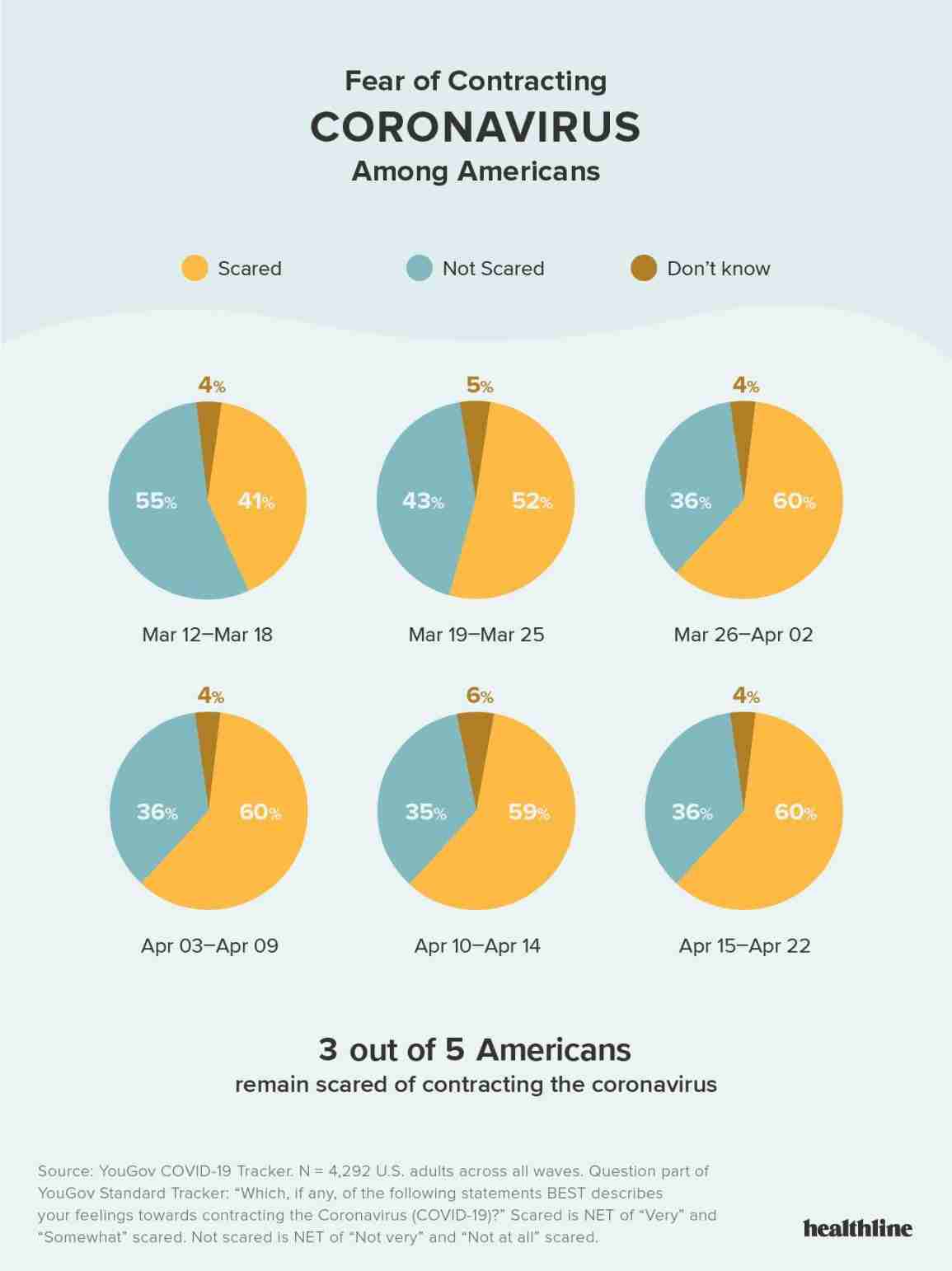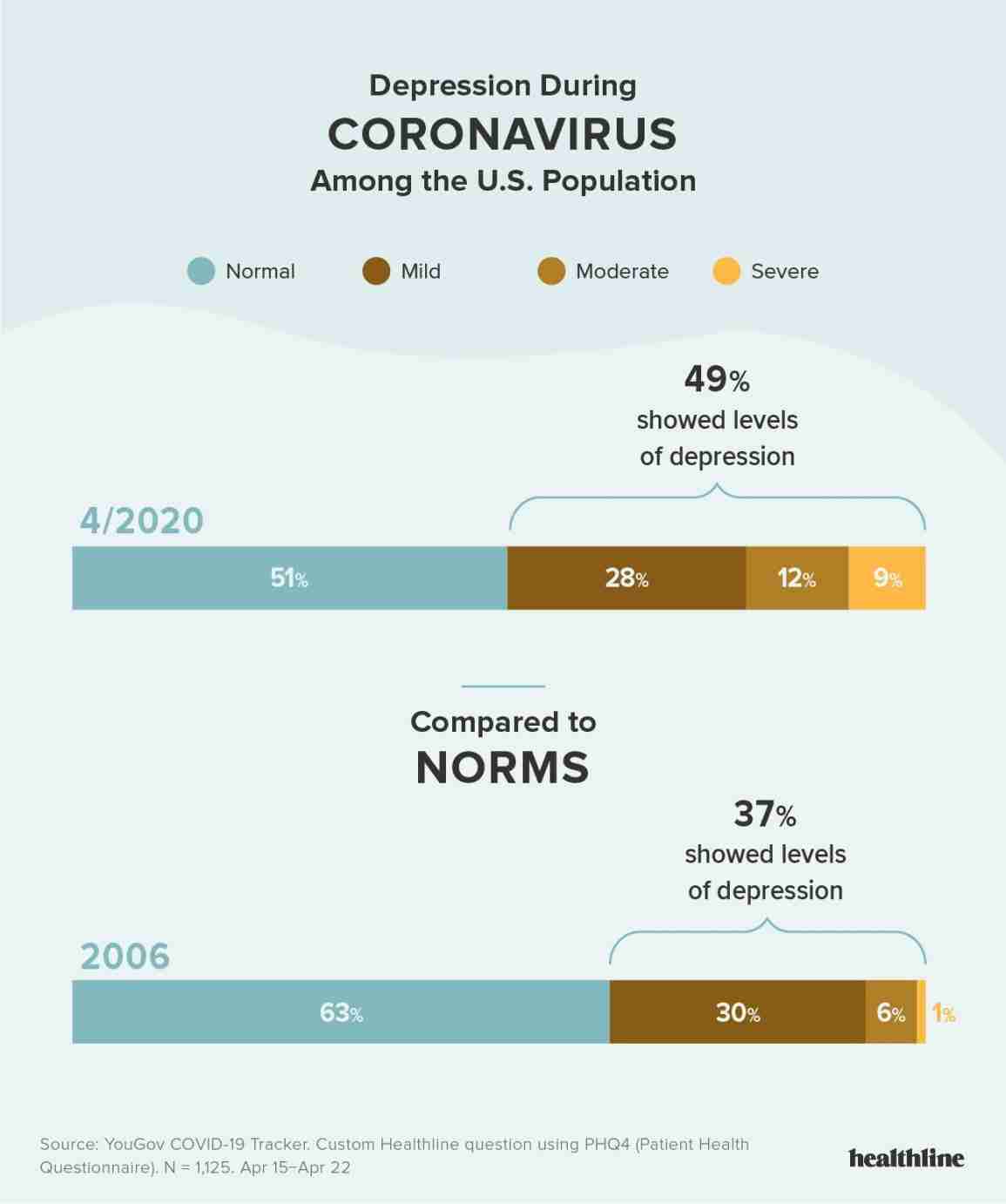
- Americans are reporting significant and sustained increases in symptoms of depression and anxiety related to the COVID-19 pandemic, according to recent data from Healthcare Website and YouGov’s COVID-19 tracker.
- Women, minorities, people with preexisting health conditions, and adults under 34 all reported higher rates of fear and anxiety.
- The number of people reporting these symptoms are well above historical norms.
- Experts caution that spotting symptoms of mental health issues could be especially challenging given the current environment of stay-at-home orders and physical distancing.
All data and statistics are based on publicly available data at the time of publication. Some information may be out of date.
There is no playbook for COVID-19.
There is no guideline that explains how isolation should be done, how hospitals should be prepared, or what we can expect when businesses begin opening again.
The truth is, much of what we are doing is unscripted, unknowable, and uncertain.
And that, it turns out, could be creating a great deal of anxiety, fear, and even depression for Americans.
Since the beginning of the COVID-19 pandemic and isolation efforts in March, Americans have been reporting increasing pressure on their mental health, according to research from Healthcare Website conducted through YouGov’s COVID-19 tracker.
Whether it’s because they’ve lost a job or fear losing one, they’re struggling to piece together money to pay bills, or they’re worried about their health and safety (or that of everyone in their house), the continuous onslaught of worry and insecurity is leading to greater mental health issues than before.
Today, Americans are reporting more symptoms and signs of depression, anxiety, and fear than historic norms. What’s more, the same Healthcare Website poll found that this increase has been sustained for several weeks and showing no signs yet of fading.
Three in five Americans reported that they fear they’ll contract the virus, according to YouGov’s COVID-19 tracker conducted between April 13th and April 20th.
And the effects of this fear may not be felt equally in all groups: Women report being concerned more than men (64 percent to 55 percent).
Not surprisingly, perhaps, people with preexisting health issues also reported higher rates of fear and anxiety.
Hispanic people were nearly twice as likely to say they’re “very scared” compared to white people (29 percent to 16 percent). Twenty-six percent of black people were “very scared” in the survey.
Surprisingly, people in younger age groups were more likely to rate themselves as “very scared” of getting sick.
Twenty-two percent of adults 18 to 34 years old said they were “very scared,” but only 16 percent of people 55+ considered themselves “very scared.”

And the self-reported incidence of depression is also higher than historic norms right now.
In our survey, 49 percent of respondents showed some signs of depression, ranging from mild to severe, as measured by the
Historically, that number is around 37 percent.
It’s important to note that the comparative data for the depression “norms” come from research conducted in Germany, so it’s not necessarily representative of Americans.
In fact, Bernd Löwe, the researcher for the story, which first ran in 2009 in the journal Psychosomatics, told Healthcare Website that, “In some studies the levels of depression and anxiety are slightly higher in the USA than in Germany. This should be taken into account in the interpretation.”
Still, comparisons show that the rate of these mental health issues are likely up and still climbing.

Depression, like anxiety and fear, often has clear symptoms: a depressed mood; feeling sad, empty, or hopeless; having difficulty with day-to-day tasks; increased fatigue; and sleep difficulties.
Among the most concerning symptoms of depression are thoughts of death, suicidal ideation, and developing a plan for suicide.
Even anxiety’s signs and symptoms are usually easily recognized. People with generalized anxiety tend to worry excessively and find it difficult to control that worry or stop it, even with logic.
This can lead to feelings of being “on edge,” and it may cause symptoms like sleep disturbances and even heart palpitations.
But there’s one problem with recognizing these conditions right now: Everything is all kind of messed up. And that makes spotting symptoms hard.
Some of these symptoms can be challenging to spot right now, says Timothy J. Legg, PhD, PsyD, MSN, MPA, a board certified geriatric and psychiatric mental health nurse practitioner, licensed psychologist, and member of Healthcare Website’s Medical Affairs team.
“In the early weeks of the epidemic, flour, sugar, yeast, and other baking products disappeared from grocery store shelves. Some people may attribute weight gain to the fact that their gyms are closed and that they have been baking or cooking more than they had been, while others may be experiencing weight loss that may be due to depressive symptoms and dismissing it as, ‘Well, I’m not doing much, so I haven’t been hungry.’”
Changes in sleep patterns or insomnia could also be considered symptoms of a larger problem.
“Another symptom that can be challenging — one that is easy to explain away — has to do with changes in sleep. ‘Why wouldn’t I sleep a bit more? I don’t have anywhere to go,’ or ‘I’m catching up on sleep that I don’t get usually!’” Legg says.
“All of these sound like plausible excuses and ways to ‘explain away’ some features that may signify depression or anxiety.”
That’s precisely what makes spotting burgeoning mental health issues problematic — and it may be what keeps people from seeking help if they need it. It’s hard to know what is to be expected and what isn’t.
“Fear is a normal and adaptive response to a perceived threat,” says Carla Manly, PhD, a clinical psychologist in Santa Rosa, California, and author of “Joy from Fear.”
“When feelings of fear are evoked, an individual will respond instinctively with a ‘fight or flight’ response.”
This response, however, is meant to be temporary. It’s meant to help us in a moment of intense emotional need; it’s not meant to last weeks, even months, as it is right now.
“When fear becomes chronic, the ‘fight or flight’ stress response remains chronic. This can create anxiety, ongoing stress, depression, suicidality,” Manly says. “The individual may feel irritable, exhausted, anxious, hyper-vigilant, angry, and emotionally dysregulated.”
Couple that with other behavior changes likely occurring during COVID-19 stay-at-home orders, like irregular eating and sleeping patterns and shifting energy use, and it’s a recipe for mental health disaster.
“Everyone is worried, so it can be difficult to pick out what is ‘clinically significant’ anxiety that may warrant help from the anxiety everyone is having at such uncertain times,” says Dr. Ramani Durvasula, a licensed clinical psychologist and professor of psychology.
“Apathy is another. Lots of people are reporting lethargy from a loss of schedule, loss of social stimulation, loss of routine, and loss of job. It’s not surprising under these conditions, but it raises the specter of whether it is clinically significant.”
She continues, “Social isolation is something that can be a marker of mental health issues, but we need to dig deeper and determine whether it is a by-product of distancing, or an avoidance of other people through platforms that are available.”
In short, recognizing the signs and symptoms that anxiety, depression, and fear cause is harder now than ever, and it falls on individuals and professionals alike to find resources that can help figure out what’s normal, what’s not, and where help may be best focused.
What can feel difficult to grasp on “bad” days during the COVID-19 pandemic is that everything you feel is understandable and often unavoidable.
But it’s also not entirely unique, and you are not alone.
The experts Healthcare Website spoke with offered some resources and tips, both traditional and newly acquired in these times, for coping with the mental health changes so many are experiencing.
Find a therapist
“I highly recommend finding therapists who are providing treatment online,” Legg says. He points to sources like the American Psychological Association’s Psychologist Locator as one way to find someone.
“I have transitioned most of my practice to the online environment as a result of COVID-19,” he says, “and my clients seem to have taken well to it. I have also had a group of people who were not regular patients per se, but just wanted to check in for some support. The use of telepsych has truly helped.”
Even smartphone apps for therapy allow you to connect with a mental health expert. While not free, many of these services offer lower-cost alternatives to traditional psychotherapy.
Be patient with yourself
No one has experienced this. No one should expect to get it “right.” As Legg reminds, this is like nothing else we’ve ever experienced.
“These are trying and fearful times,” he says. “Allowing yourself to experience natural emotions without judging those emotions can be powerful.”
Ramani adds that you should pace yourself. “Grocery shopping takes time now,” she says.
“It’s no longer about popping in for a quart of milk. Recognize that some things are taking longer, and that you may not be as productive as always.”
Remember to breathe
Let a wash of calm overwhelm you and help you find a bit of solitude when you’re feeling untethered.
“A few deep breaths with eyes closed and feet firmly planted on the ground can actually do wonders,” Ramani says.
Move around if you can
“Find some time to exercise,” Legg says. “Clearly you can’t get to the gym, but even if it is doing ‘laps’ around your house or pulling out a few cans of soup to make ‘improvised’ weights, exercise can be quite beneficial for stress and overall mood.”
He also suggests checking out YouTube for some videos you can do, too.
Set a routine
“Routine is important for all of us, but all the more so when a person is struggling with anxiety, sadness, and other issues,” Ramani says.
“Don’t be too aspirational or perfectionistic in the schedule. Keep it simple, but have one — a wake-up time, a routine upon waking, a goal for the morning, a goal for the afternoon, some form of activity, and pleasurable activities. This can be difficult for someone who is experiencing apathy, but even just having a wake-up time can be a start.”
Make social contact
You can’t make physical contact, but you can make contact with others nonetheless. Try FaceTime or Zoom with your family, Ramani suggests.
Even online support groups can connect you with others, Ramani says.
Nothing about the days we are living in is ‘normal.’
There is no previous experience with which to compare, except what was before we had ever heard of COVID-19.
And that comparison shows us that Americans are feeling more depression, anxiety, and fear than normal. But there is help if you need it.
“This is an incredibly challenging time. Never have Americans experienced a pandemic that has impacted employment, education, and the economy the way COVID-19 has,” Legg says.
“We are all living in very stressful and uncertain times right now. If you are feeling stress and are noticing that it is impacting your mood, sleep, or eating patterns, don’t wait. Get help. You will be glad that you did.”
YouGov, an international research data and analytics group, has been running a weekly global COVID-19 tracker across 26 countries, including the United States, since March 12, 2020, to explore and track the impact of the COVID-19 pandemic on people’s lives.
On April 3, 2020, Healthcare Website Media incorporated five custom questions as part of the YouGov COVID-19 Tracker, which are being reported on a biweekly basis.
The tracker includes a total of 1,000 responses every other week.
